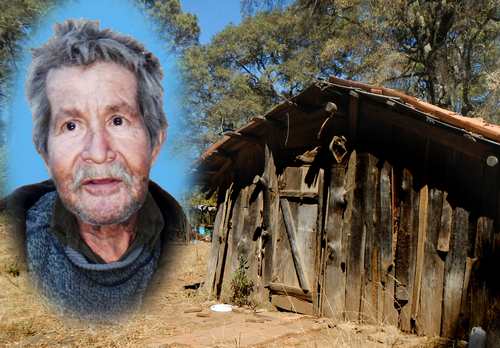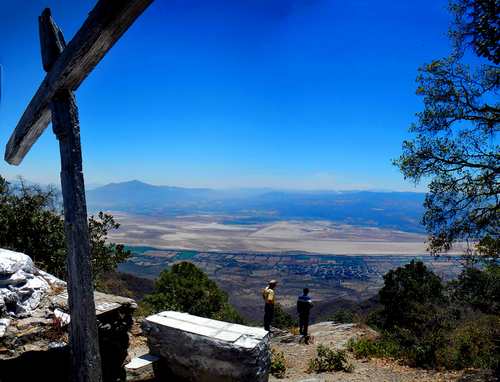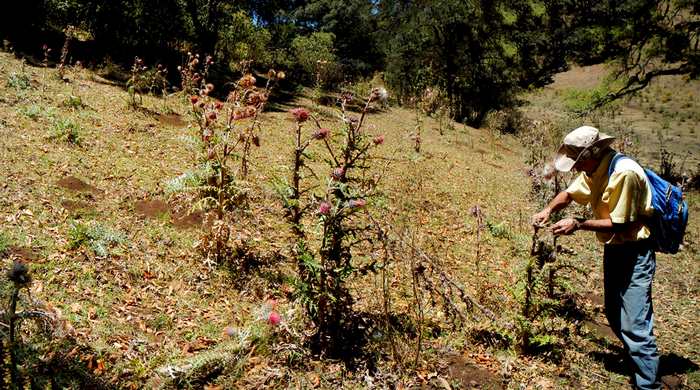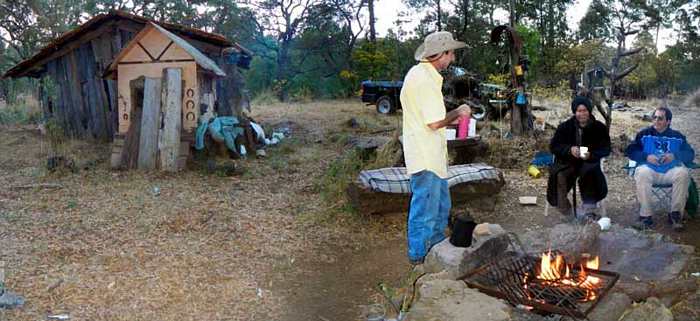|
By John Pint
 Many
years ago I heard a rumor that there was a “Man of Letters” living in
the hills near Atemajac de Brizuelas, high above the salt flats of
Sayula,about 75 kilometers southwest of Guadalajara, Mexico's
second-largest city.. “His name is Alfredo and he’s been living in a
cabin all by
himself for 15 years,” a friend told us. Many
years ago I heard a rumor that there was a “Man of Letters” living in
the hills near Atemajac de Brizuelas, high above the salt flats of
Sayula,about 75 kilometers southwest of Guadalajara, Mexico's
second-largest city.. “His name is Alfredo and he’s been living in a
cabin all by
himself for 15 years,” a friend told us.
Curious to meet a
modern hermit, we climbed a bumpy dirt road to a lonely area full of
tall pines. At an altitude of 2700 meters, we came to a small, rustic
shack. It was the home of Alfredo the Hermit, alright, but he was
hardly alone. Seven or eight visitors were seated with him on stumps
and logs behind his cabin and—it was hard to believe—they were all
engaged in a lively discussion of the Nature of Time. We were invited
to join in and later enjoyed listening to the haunting melody of the
quena, the “flute of the Andes,” played by one of the guests, until it
grew dark and very cold, even though we were in the middle of May,
traditionally Western Mexico’s hottest month.
This was such an
impressive experience that, sixteen years later, I found myself
wondering whether Alfredo was still up there pondering the great truths
of life in the cold mountain air. Finally I began hunting for
his
lonely wooden cabin, whose location was now only a hazy memory. Thanks
to the help of friends willing to participate in my craziest schemes,
we searched all along the road to Atemajac and discovered marvelous
places like “the No-Longer-Balanced Rock,” the Amor Corazón Restaurant
and the Zero-Gravity Hang-Glider Launch Pad (all described in my column
in the Guadalajara
Reporter) but when we asked about hermits, not a
soul had ever heard
of good old Alfredo.
My mistake was never consulting my friends
in Jalisco’s oldest hiking club, CEO (Cuerpo de Exploradores del
Occidente). Finally, weeks ago, I casually asked long-time CEO member
Mario Guerrero if he’d ever heard of the Hermit of the Highlands.
“Hermit? Ah, el Hermitaño…¡claro que sí! Se llama Alfredo…”
It
turned out CEO members had discovered Alfredo long ago and since then
have been visiting him about twice a year. “His name is Alfredo Leal
and he was once with the Autonomous University of Guadalajara. He won’t
accept money from visitors, but he’s grateful for gifts of food. Why
don’t we bring him some supplies next weekend?”
So it was that four
of us squeezed into Mario’s truck last Saturday and followed a road out
of Atemajac de Brizuelas that practically brought us to Alfredo’s
doorstep, …er, well, to the adobe brick that serves as a doorstep.
Along the way, my friend Gregorio Leñero spotted a plant on the
roadside.
We screeched to a stop and jumped out. “This is Cardo
Santo,” announced Goyo, leading us to a tall thistle. “It has amazing
medicinal properties, but you can’t find it just anywhere.”
I
looked at the altitude reading on my GPS. “I think you’re going to find
plenty of it here,” I told him. “We’re at 2700 meters (8,858 feet),
about the same altitude as the crater of Tequila Volcano, where I saw
this same thistle growing like—ahem—a weed.”
Ten minutes later,
we were at Alfredo’s cabin, which looked to me exactly the same as it
had in 1997. Alfredo, however, had not proven as durable. Although his
mind was still sharp and feisty, his body had not kept up and walking
just a few steps, with the help of a cane, required all of his energy.
Nevertheless, Alfredo told us he was content with his lifestyle and
still working on knowing himself. A roaring campfire and good food kept
us going for quite a while, but it soon grew so cold I had to head for
my tent where I managed to warm up inside of two sleeping bags…until
about 4 AM, when I actually had to insert my lower extremities—still
inside the sleeping bags—into a giant plastic garbage bag. Hey, don’t
knock it; that did the trick and I slept like a baby!
 The
next day, after a hearty breakfast, we took a four-kilometer hike to a
breathtaking mirador named La Cruz del Hermitaño, in Alfredo’s honor,
of course. This walk took us through really tall pine and oak trees.
The scenery along the way was gorgeous—even though we are just about at
the height of the dry season—and the wide path we followed looked ideal
to me for mountain biking. A short climb up a hill brought us to two
freshly painted crosses and the always impressive view of the salt
flats of Sayula far below us. The
next day, after a hearty breakfast, we took a four-kilometer hike to a
breathtaking mirador named La Cruz del Hermitaño, in Alfredo’s honor,
of course. This walk took us through really tall pine and oak trees.
The scenery along the way was gorgeous—even though we are just about at
the height of the dry season—and the wide path we followed looked ideal
to me for mountain biking. A short climb up a hill brought us to two
freshly painted crosses and the always impressive view of the salt
flats of Sayula far below us.
As I had predicted the day before,
we came across a lot of Cardosanto (St. Benedict Thistle) which sources
on the internet say normally does not grow taller than 60 centimeters.
Well, in them thar hills it’s close to two meters high and grows in
such profusion that we named one area “Cardolandia.” Goyo wanted to
make teas and tinctures from the flowers, leaves and root of this plant
and I helped him collect five big bags of the stuff. “This plant is
marvelous,” said Goyo, delighted with his find. “It helps regenerate
cells and is especially good for the liver. It’s used a lot to treat
problems like Diabetes and Lupus (a systemic autoimmune disease).”

Alfredo
looked extremely dejected when it came time for us to say good-bye and
we assisted him in slowly walking from his favorite chair (under the
open sky) to his bed. “We’ll be back after the rainy season,” (during
which these roads become extremely slippery), we told him. He said
nothing, but the sad look in his eyes spoke volumes. Alfredo needs
help, but given the life-style he’s decided to follow, I wonder what
can be done.
If you’d like to visit Alfredo or just take in the
view from the Hermit’s Cross, follow the directions below, but note
that the long stretch of dirt road between Atemajac and the community
of École can become extremely slippery during the rainy season.
How to get there
From Guadalajara, take
highway 54 southwest and follow the “libre” signs for Colima. About 15
kilometers south of Acatlán de Juárez, watch for the turnoff to
“Tapalpa via Atémajac.” Atémajac is 32 km to the southwest. At N20
07.951 W103 43.107, turn off the Atémajac road onto a dirt road
signposted for École. Follow this road southeast for 7.5 kilometers.
When you reach N20 05.963 W103 39.712, you turn left for École and
right to head for the Hermit. After driving east 4.5 kilometers, you’ll
come to the locked gate (N20 05.606 W103 37.469) not far from Alfredo’s
cabin (which is at N20 05.594 W103 37.373). As for the Hermit’s Cross
Lookout, hike or bike along a wide trail heading south and then east
for around four kilometers. The cross is at N20 04.954 W103 35.876.
Driving time from Guadalajara to the cabin: about two hours.

|

